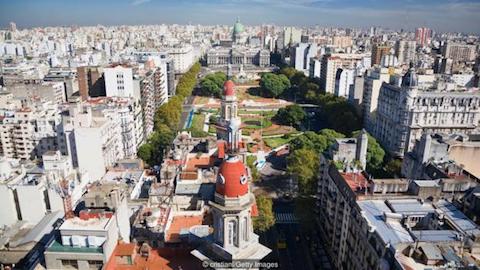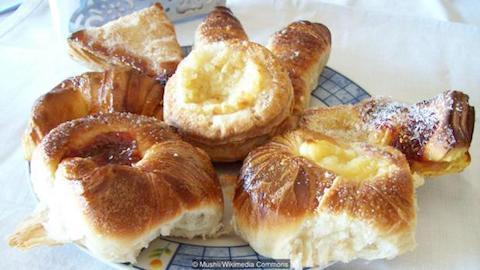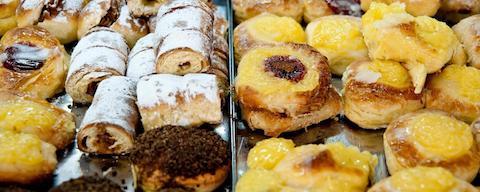The first time I visited a pastry shop in Buenos Aires, I thought my ears were deceiving me. All around me, porteños (Buenos Aires natives) were ordering their favourite pastries to accompany their morning coffee. But I couldn’t believe what they were requesting: did that person just order six friar’s balls? Along with half a dozen little cannons?
The sugar-topped fritters known as bolas de fraile (friar’s balls) and the puff-pastry cones filled with dulce de leche called cañoncitos (little cannons) are just two examples of Argentina’s oddly named facturas (pastries). There are also bombas (bombs), similar to profiteroles, and libritos (little books), folded pastry layers that resemble pamphlets.
While the pastries themselves are certainly sweet, the origin of their names is more sinister: in the late 1800s, a union of anarchist bakers used their pastries as propaganda.
“The majority of Argentines don’t really know the significance of the pastry names, and why they’re called what they are. They think they’re just quirky, tongue-in-cheek nicknames,” said Vicente Campana, pastry chef and professor at the National University of Entre Rios. “But really, it was the anarchists – who were anti-government, anti-police and anti-church – who gave them those names to draw attention to their political leanings.”
Blasphemy and gastronomy have long gone hand in hand
Blasphemy and gastronomy have long gone hand in hand. In the early 16th Century during the Ottoman attack on Vienna, Austrians created the medialuna, a crescent-shaped puff pastry similar to a croissant, in reference to the crescent moon and star on the Turkish flag and a widely recognised symbol of Islam. Austrians would eat these crescents in front of Turkish soldiers as a way to blaspheme their occupiers. Centuries later when the European pastries made their way to South America, the name stuck; the only difference is that in Argentina, medialunas are topped with a sticky layer of saccharine syrup.
Even the term ‘facturas’ is loaded. The Latin root of the word is facere, meaning to make or create, but the modern-day Spanish noun means ‘invoice’. The use of the word ‘facturas’ to refer to all pastries (which is unique to Argentine Spanish) was a clever way for members of the baker’s union to subversively call attention to the value of their labour.
As I sat dunking my medialuna into my café con leche, customers crowded the counter. As quickly as display cases were emptied, new batches of pastries emerged, and each time the kitchen door opened, the clatter of pots and pans flooded the dining room. I can’t imagine bakeries in the 19th Century were much different, but back then, bakers were just some of the country’s working-class citizens who felt underappreciated.
After declaring independence from Spain in 1816, Argentina’s political scene was turbulent: civil war waged between centralist and federalists, and threats of invasion by foreign powers were frequent. In 1853, after 37 long years of disorder, the country adopted its first constitution. The relative peace that ensued allowed Buenos Aires to grow exponentially, becoming a worldwide hub of business.
However, resentment of the government was growing among the lower and middle class. The new constitution had done little to prevent electoral fraud, and many citizens viewed their leaders as corrupt. Meanwhile, inflation posed a serious threat to the country’s economy and workers’ livelihoods.
Simultaneously, anarchist and communist schools of thought were spreading across Europe, with growing demands for the rights of workers.

In the mid-19th Century, Buenos Aires became a hub of business and welcomed many European immigrants (Credit: Credit: cristianl/Getty Images)
Throughout the mid- to late 19th Century, Buenos Aires welcomed large numbers of European immigrants, predominantly from Spain and Italy, who were looking for a chance at a new life. They brought with them ideas for a society free from sovereign, military or religious rule – one in which everyone was treated equally.
One such anarchist was Italian exile Errico Malatesta, whose anti-government actions included writing socialist publications and organising anarchist rallies. After his revolutionary escapades led him to a prison sentence, he fled the continent by hiding in a shipping box containing a sewing machine that was bound for South America.
Arriving in Buenos Aires in 1885, he quickly fell in with other European anarchists, including fellow Italian Ettore Mattei, who had recently formed a trade union for the city’s bakers – for what societal role could be more important than that of the people who provide the city with its daily bread?

The use of the word 'facturas' was a clever way for bakers to call attention to the value of their labour (Credit: Credit: Mushii/Wikimedia Commons)
Two years later, in 1887, the Sociedad Cosmopolita de Resistencia y Colocación de Obreros Panaderos (The Cosmopolitan Society of Resistance and Placement of Bakery Workers) went on strike, closing down the city’s bakeries for more than a week. As a part of the movement, union members renamed baked goods with blasphemous monikers targeting the government, the military and the church – the institutions anarchists believed stood in the way of individual freedom. What better way to elevate awareness of a cause than by changing the names of something residents eat on a daily basis?
The coming years brought rolling work stoppages across a variety of industries, from carpentry to mechanics to shoemakers, with Malatesta standing at the forefront of the movement. He left Buenos Aires in 1889, but his legacy of inspiring workers to stand up for their rights was long lasting, with the anarchist movement thriving in Argentina throughout most of the 20th Century.
Today, in glass cases in bakeries across the country, dulce de leche-filled suspiras de monja (nun’s sighs) sit beside vigilantes (vigilantes), straight pastries meant to look like police batons. You can call the pastries cream puffs, profiteroles or croissants, but most Argentines still use the more irreverent names.
Now when I visit my favourite Buenos Aires cake shop and order a bag full of friar’s balls and little cannons, I know I’m not only about to enjoy something sweet with my café con leche, but I’m also honouring a fight for equality.
Join over three million BBC Travel fans by liking us on Facebook, or follow us on Twitter and Instagram.


Spread the word